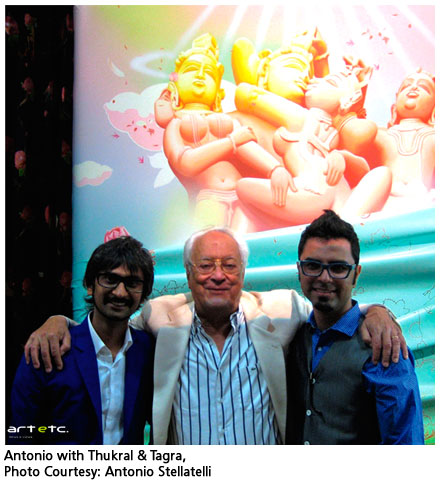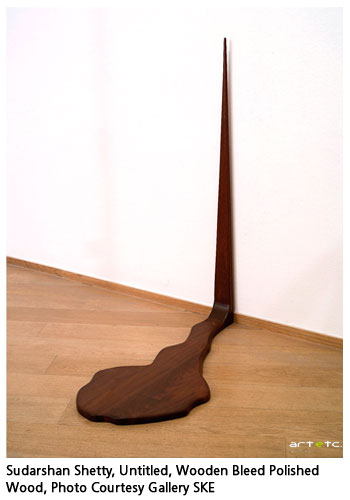- Publisher's Note
- Editorial
- What's Behind This Orange Facade!
- “First you are drawn in by something akin to beauty and then you feel the despair, the cruelty.”
- Art as an Effective Tool against Socio-Political Injustice
- Outlining the Language of Dissent
- Modern Protest Art
- Painting as Social Protest by Indian artists of 1960-s
- Awakening, Resistance and Inversion: Art for Change
- Dadaism
- Peredvizhniki
- A Protected Secret of Contemporary World Art: Japanese Protest Art of 1950s to Early 1970s
- Protest Art from the MENA Countries
- Writing as Transgression: Two Decades of Graffiti in New York Subways
- Goya: An Act of Faith
- Transgressions and Revelations: Frida Kahlo
- The Art of Resistance: The Works of Jane Alexander
- Larissa Sansour: Born to protest?!
- ‘Banksy’: Stencilised Protests
- Journey to the Heart of Islam
- Seven Indian Painters At the Peabody Essex Museum
- Art Chennai 2012 - A Curtain Raiser
- Art Dubai Launches Sixth Edition
- "Torture is Not Art, Nor is Culture" AnimaNaturalis
- The ŠKODA Prize for Indian Contemporary Art 2011
- A(f)Fair of Art: Hope and Despair
- Cross Cultural Encounters
- Style Redefined-The Mercedes-Benz Museum
- Soviet Posters: From the October Revolution to the Second World War
- Masterworks: Jewels of the Collection at the Rubin Museum of Art
- The Mysterious Antonio Stellatelli and His Collections
- Random Strokes
- A ‘Rare’fied Sense of Being Top-Heavy
- The Red-Tape Noose Around India's Art Market
- What Happened and What's Forthcoming
- Art Events Kolkata, January – February 2012
- Mumbai Art Sighting
- Art Bengaluru
- Delhi Dias
- Musings from Chennai
- Preview, February, 2012 – March, 2012
- In the News-February 2012
- Cover
ART news & views
The Mysterious Antonio Stellatelli and His Collections
Issue No: 26 Month: 3 Year: 2012
Collector's Corner
by Franck Barthelemy
 When I read the India Art Fair programme, an event caught my attention: the launch of a book titled The Indian Renaissance. In art history, we are usually more familiar with the Italian Renaissance, this period that closed the Middle Age in Europe. Giotto, Botticelli, Vinci, Michelangelo turned the visual art world upside down with the help of poets and writers like Boccaccio, Castiglione or Machiavelli. It was a new start, a dip into a modern (or rather more modern) world. Quite curious to find out more about the book, I called the author, Antonio Stellatelli, for a coffee. He accepted the invite.
When I read the India Art Fair programme, an event caught my attention: the launch of a book titled The Indian Renaissance. In art history, we are usually more familiar with the Italian Renaissance, this period that closed the Middle Age in Europe. Giotto, Botticelli, Vinci, Michelangelo turned the visual art world upside down with the help of poets and writers like Boccaccio, Castiglione or Machiavelli. It was a new start, a dip into a modern (or rather more modern) world. Quite curious to find out more about the book, I called the author, Antonio Stellatelli, for a coffee. He accepted the invite.
In a dazzling off-white suit, the 83 year old gentleman from Barletta, a small city on the Adriatic coast of Italy, greeted me generously. For a second, I thought I knew him for decades and I was casually catching up with my old friend. His accent was chanting; his smile warm. He was obviously happy to talk about his new baby, his Indian art collection. As an introduction he said, “You know, I love art”.
Antonio's passion for art is not new. He is starting his 7th collection in India. The first six were focussed on Italian contemporary art. In 1987, he published Ten Artists from Corrente1 to share for the first time his Italian discoveries with the public. And since then he has not stopped. When he feels he has gathered enough for a collection, Antonio shows it and eventually donates it to a museum or an institution. His passion for art goes together with his passion for sharing and giving back to the society. He 'contributes to history', as he puts it.
 A few years ago, he shifted his interest from Europe to emerging countries when he realized that the European art scene was turning out to be far too focused on money. Antonio does not collect art as an investment though he worked most of his life for financial institutions. He looked at the Asian art scene and thought this continent could become his next hunting territory. Actually, it was more than a 'look'. Antonio has a very rigorous approach to his collections. He reads a lot about art and history and meets experts and friends to make his final opinion. At the same time, Antonio is proud to highlight that he does not buy any piece of art without meeting the artist. He needs to feel the emotions that were put into the art works. He needs to empathise with the artist. He is 'looking for the soul' of the artist. He wants to connect with the artist and his/her practise.
A few years ago, he shifted his interest from Europe to emerging countries when he realized that the European art scene was turning out to be far too focused on money. Antonio does not collect art as an investment though he worked most of his life for financial institutions. He looked at the Asian art scene and thought this continent could become his next hunting territory. Actually, it was more than a 'look'. Antonio has a very rigorous approach to his collections. He reads a lot about art and history and meets experts and friends to make his final opinion. At the same time, Antonio is proud to highlight that he does not buy any piece of art without meeting the artist. He needs to feel the emotions that were put into the art works. He needs to empathise with the artist. He is 'looking for the soul' of the artist. He wants to connect with the artist and his/her practise.
The adventurous open minded collector went to China in 2009 to check the art scene. He got fascinated. And when he came to India in 2011, he got amazed. He visited a few studios in Mumbai and Delhi and decided to collect Indian contemporary art. He still remembers his visits to Sunil Gawde and Bharti Kher's studios with joy, the way a kid would remember a delicious candy. This attitude is very representative of Antonio's way of life: he enjoys it to the fullest and he is not shy to demonstrate it. Beside art in various forms, including music and literature, he loves nature, woman, food and speed. When he speed-drives his car on the German highways, the only roads where it is allowed in Europe, he enjoys the thrill tremendously. There is no time to look back. He looks forward. He pays attention to details and at the same time anticipates. 'I like driving fast and my life is the same', he said. He believes that what one does with one's life is less important than how one does it. And by the way, Antonio has not changed his car for many years; he prefers buying a piece of art!
The way Antonio collects, depicts another of his peculiarities: he is free. There is no trend and fashion that attracts him. When he first started his Corrente collection, it was against the main stream fashion. When he now builds up his Indian collection, it is also out of the main stream art trend in Europe. With a lot of humility, Antonio briefly mentioned that he has done the War (WWII) and was part of the Resistance, been in a group of people which decided to fight fascism when their country followed other paths. His love for freedom is genetic and no one would put him within a frame. Antonio pushes the boundaries of his collections and constantly explores new avenues. Internet is one for instance. He finds the concept of virtual reality fascinating. In a world where the media are changing, 'we need to do something' he said. I would not be surprised if he started a collection focused on these new media soon.
 With such knowledge and experience of the art world, it would be natural for most of the people to think about setting up a museum or a foundation to leave back a legacy. Antonio is not interested. His journey is personal. While collecting, he lives with the art works at home for a while; he shares his enthusiasm with friends and then donates them. Fame does not interest him. Having his name inscribed in gold letters on a plate does not seem to be his objective in life. To convince me, as if I had to be, he told me he refused to become a member of parliament in 1987 when Berlusconi approached him. His mission with art makes his plate full besides being the head of a family of four sons and seven grandchildren.
With such knowledge and experience of the art world, it would be natural for most of the people to think about setting up a museum or a foundation to leave back a legacy. Antonio is not interested. His journey is personal. While collecting, he lives with the art works at home for a while; he shares his enthusiasm with friends and then donates them. Fame does not interest him. Having his name inscribed in gold letters on a plate does not seem to be his objective in life. To convince me, as if I had to be, he told me he refused to become a member of parliament in 1987 when Berlusconi approached him. His mission with art makes his plate full besides being the head of a family of four sons and seven grandchildren.
Antonio could spend hours talking about art without getting bored even for a second. It would no doubt be an amazing experience to be invited at his house and see the art he lives with at a point of time. He does not hesitate to say that his house is open to art lovers to discuss art … but not to arty socialites who would only be interested to find out how much is what. I hope one day I will have the honour. Like many art lovers, I am looking forward to seeing Antonio's Indian Renaissance collection, somewhere in India or Europe. I am also impatient and excited to discover his next collection focussed on Chinese contemporary art. And I am sure there are many more to come. Hats off Antonio Stellatelli!
Reference.
1Dieci artisti di Corrente